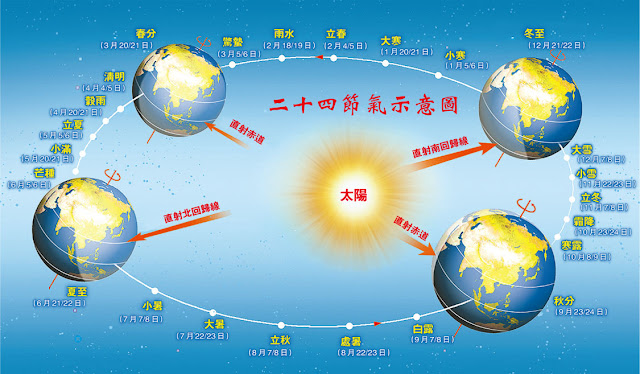 |
Diagram showing the points along the earth’s orbital path
that mark the 24 Solar Terms
(Image: Original source unknown)
|
The Twenty-four Solar Terms (二十四節氣 Ershisi Jieqi),
also translated as the Twenty-four Seasonal
Division Points or the Twenty-four Fortnightly
Periods, is an important element of the traditional Chinese calendar.
The traditional Chinese calendar
is a lunisolar calendar (陰陽合歷 Yinyang He Li).
In other words, it combines elements of both the lunar and solar calendars.
The Chinese solar calendar is
based on the division of the entire year separated into 24 periods, with each
period correlating to an important astronomical phenomenon, natural phenomenon,
seasonal change, or climatic related change. These periods are the Twenty-four Solar Terms. Each one
occupies 15 degrees of the ecliptic (the apparent path that the sun travels
through in the sky from the perspective of the earth). Because China was
traditionally an agrarian society, this type of calendar was very important and
practical for agriculture and farming.
Here are the names of the 24 Solar
Terms in the Chinese calendar:
1. Li Chun (立春 Start of spring)
2. Yu Shui (雨水 Rain water)
3. Jing Zhe (驚蟄 Awakening of hibernating insects)
4. Chun Fen (春分 Spring equinox)
5. Qing Ming (清明 Clear and bright)
6. Gu Yu (穀雨 Grain rain)
7. Li Xia (立夏 Start of summer)
8. Xiao Man (小滿 Lesser full grains)
9. Mang Zhong (芒種 Grain in ear/beard)
10. Xia Zhi (夏至 Summer solstice)
11. Xiao Shu (小暑 Small heat)
12. Da Shu (大暑 Great heat)
13. Li Qiu (立秋 Start of autumn)
14. Chu Shu (處暑 End of heat)
15. Bai Lu (白露 White dew)
16. Qiu Fen (秋分 Autumn equinox)
17. Han Lu (寒露 Cold dew)
18. Shuang Jiang (霜降 Frost descends)
19. Li Dong (立冬 Start of winter)
20. Xiao Xue (小雪 Small snow)
21. Da Xue (大雪 Great snow)
22. Dong Zhi (冬至 Winter solstice)
23. Xiao Han (小寒 Small cold)
24. Da Han (大寒 Great cold)
From the above list, the following
solar terms are related to astronomical phenomena: Spring equinox, Summer solstice,
Autumn equinox, and Winter solstice.
The following are related to
natural phenomena: Awakening of hibernating insects, Clear and bright, Lesser
full grains, and Grain in ear/beard.
The following are related to
seasonal changes: Start of spring, Start of summer, Start of autumn, and Start
of winter.
The following are related to climactic
changes that include temperature and precipitation level changes: Rain water,
Grain rain, Small heat, Great heat, End of heat, White dew, Cold dew, Frost
descends, Small snow, Great snow, Small cold, and Great cold.
These solar terms are used in
conjunction with the lunar phases to make up the traditional Chinese calendar.
Text © 2016
Harry Leong
No comments:
Post a Comment